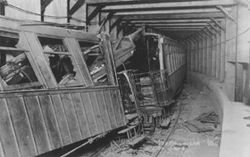Malbone Street ( Malbone Street Wreck ) - a major train accident that occurred on Friday, November 1, 1918 , in a tunnel under Malbon Street in Flatbush ( borough of brooklyn ), when the subway train on the way to the station " Prospect Park " got off the rails and crashed into the wall of the tunnel. According to various estimates, between 93 and 102 people died in the crash, which makes it one of the largest rail accidents in the country.
| Crash on malbon street | |
|---|---|
 Aftermath of the crash | |
| Details | |
| date | November 1, 1918 |
| Time | 18:42 |
| A place | Flatbush , Brooklyn , New York |
| A country | |
| Railway line | BMT Brighton |
| Operator | Brooklyn Rapid Transit Company |
| Type of incident | derailment |
| Cause | overspeed |
| Statistics | |
| Trains | one |
| Dead | 93-102 |
Prior circumstances
By the fall of 1918, when World War I was nearing completion, the industrial sector was strongly developed in the United States, which supplied resources to Europe. In these conditions, urban transport barely coped with high passenger traffic during peak hours.
But in the early morning of November 1, 1918, the subway machinists suddenly went on strike. Then the transport company Brooklyn Rapid Transit Company I was forced to use anyone possible to drive trains, while conducting training under an abbreviated program. One of these people was Edward Luciano ( English Edward Luciano ), the dispatcher of the driver's point of turn, who previously drove the train only once - a year ago, and on shunting work . The drivers had to complete a 60-hour course before driving, but Luciano’s training lasted only a couple of hours. Later, Edward explained why he agreed to drive the train: "A man must earn a living ( Eng. A man has to earn a living ). " Luciano faced work on the Brighton line , which he did not know at all. The composition that he led included three motor cars (M) and two trailed (P), all of the old construction with wooden bodies. Motor cars were almost twice as heavy as trailers, so they needed to be distributed evenly in composition - M – P – M – P – M. However, in the rush to form a train, both trailer cars were coupled together, because of which the train had the composition M – P – P – M – M (car numbers: 725–80–100–726–1064).
Wreck
At rush hour in the evening, the completed train run by Edward Luciano approached the final station on the route, Prospect Park . Previously, the train entered the station through a straight tunnel, but in 1918 a line was reconstructed to connect it with the rest of the metro network, with the result that a new S-shaped tunnel was opened several weeks before the incident. The dispatcher warned the machinists that the speed limit in that tunnel was 10 km / h, but at 18:32 Luciano, trying to catch up with the schedule gap that had been allowed earlier, drove into this tunnel at a speed of at least 50 km / h. Later, Edward claimed that he began to slow down in front of the tunnel when control failed. However, the survivors claimed the opposite - inhibition was not applied until it was too late. Following at high speed along a steep curve, the cars collapsed and derailed. Thanks to the large mass, the first car remained on the track, but the light trailer cars that followed were trapped between heavy motor trains and, when they left the track, flew off to the left, then crashed into the steel pillars of the tunnel at high speed. The blow fell on the left side of the wooden bodies, as a result of which the left walls were demolished, and the passengers fell on the way. Heavy freight wagons in the tail crashed into a pile of debris and people, after which, after passing through it, they stopped after about 60 m.
As a result of the crash, the first and fourth cars were damaged, but survived, and the fifth car was not injured. The people who were driving them out of significant injuries were mostly cut by broken glass. Due to the fact that there were a lot of people in these two cars, their bodies did not have time to develop speed from the impact, and therefore they managed to avoid fractures. But, in contrast to motor cars, the trailer cars were destroyed, and the third car in the train had to be dismantled right in the tunnel, and almost all the passengers traveling in them died. The driver Luciano practically did not suffer, but, being in a state of shock, went home.
After 15–20 minutes, the city’s rescue services were finally aware of what had happened, but due to the scarcity of information, they arrived only ¾ hours later.
Implications
As a result of the crash, 93 people were killed and more than 50 were seriously injured.
Both broken trailers were excluded from the inventory, including the car number 100 dismantled directly in the tunnel. All three motor cars (No. 725, 726 and 1064) were restored and returned to service, but the road was instructed to terminate the operation of wooden cars as soon as possible. In 1920, work on connecting the Brighton line with the rest of the network was completed.
Malbon Street ( born Malbone Street ) was renamed Empire Boulevard ).
Links
- Malbone Street Wreck (Eng.) , New York Times (2 November 1918). The appeal date is October 21, 2016.